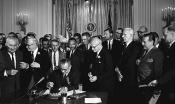webinar
Identifying Bias and Perspective When Teaching About the Civil Rights Act of 1964

This session examines the five essential practices for teaching about the Civil Rights Movement, educate for empowerment, know how to talk about race, capture the unseen, tell a complicated story and connect to the present.